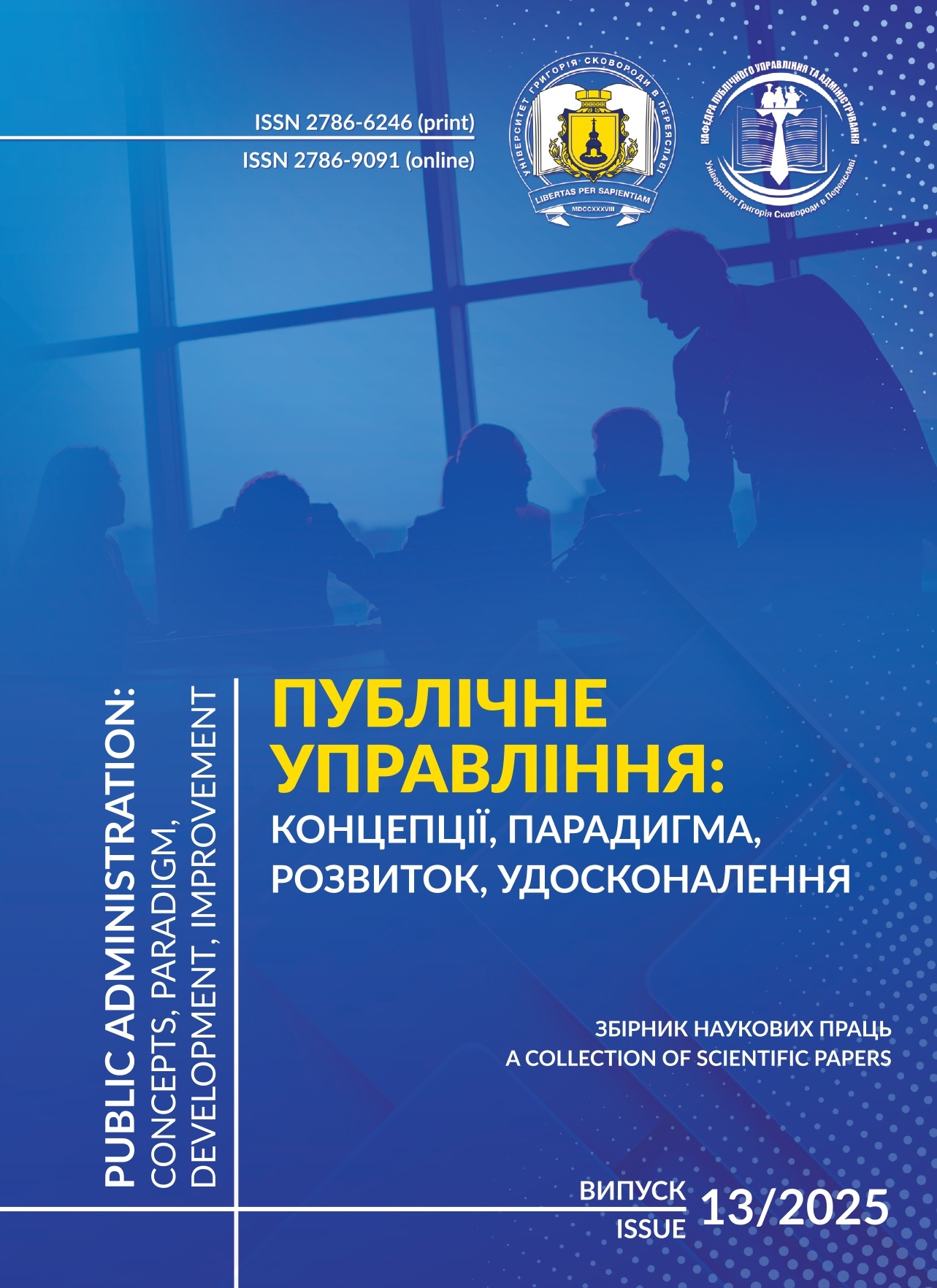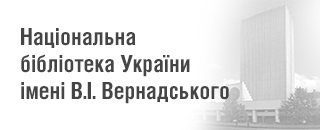THEORETICAL APPROACHES TO THE CONCEPTUAL AND CATEGORICAL APPARATUS OF RESEARCH INTO THE ISSUE OF DIGITAL TRANSFORMATION OF HUMAN RESOURCE MANAGEMENT IN PUBLIC ADMINISTRATION IN THE CONTEXT OF GLOBALIZATION CHALLENGES
DOI:
https://doi.org/10.31470/2786-6246-2025-13-61-69Keywords:
public administration, public service, public servants, digital transformation, globalization changesAbstract
The article analyzes theoretical approaches to the conceptual and categorical apparatus of research concerning the digital transformation of human resource management in public administration in the context of globalization challenges. The author notes that in scientific discourse there are at least several types of definitions of human resource management: operational-functional (human resource management as a set of policies/procedures); philosophical-systemic (human resource management as a holistic organizational philosophy/architecture of practices); strategic (human resource management as a mechanism for implementing a business strategy); resource-oriented (human resource management as a source of competitive advantage within the framework of a circular review system); role/institutional (configuration of roles and subsystems of the HR function). Definitions of «human resource management in public administration» in academic and political and managerial sources converge around three theses: normative-ethical (merit, legality, non-discrimination and accountability as constitutive conditions of any personnel actions), institutional-strategic («human resource management» as a mechanism for transforming political priorities into organizational capabilities and results) and procedural-functional (a holistic cycle from planning and selection to development, evaluation and reward, integrated into the framework of public policy). The digital transformation of human resource management in public administration in the context of globalization challenges is a multidimensional process that reflects not only the technological modernization of personnel procedures, but also a profound institutional restructuring of the civil service system under the influence of global socio-economic and political trends. In the modern world, where globalization creates new challenges for nation-states, including increased labor mobility, increased competition for talent, transnational migration processes, the digital economy, and the need to ensure cybersecurity, human resource management in the field of public administration can no longer be based solely on traditional administrative and bureaucratic approaches. It requires the integration of digital technologies, data analytics, and innovative management practices that ensure the adaptability of state institutions to the rapid changes in the global environment.
References
Dessler, Gary (2015). The Strategic Role of Human Resource Management. evergreenvmw.wordpress.com. Retrieved from https://evergreenvmw.wordpress.com/wp-content/uploads/2015/03/gary-dessler-human-resource-management-nicebrothers-blogspot-com.pdf?utm.com [in English].
Armstrong, M. (2014). Armstrong’s handbook of human resource management practice. e-uczelnia.uek.krakow.pl. Retrieved from https://e-uczelnia.uek.krakow.pl/pluginfile.php/604792/mod_folder/content/0/Armstrongs%20Handbook%20of%20Human%20Resource%20Management%20Practice_1.pdf?utm.com [in English]
Torrington, D., Hall, L., & Taylor, S. (2008). Human Resource Management. Pearson Education [in English].
Boxall, P., & Purcell, J. (2016). Strategy and Human Resource Management. Palgrave Macmillan [in English].
Guest, D.E. (1997). Human resource management and industrial relations. Journal of Management Studies, 24(5), 503–521 [in English].
Legge, K. (2005). Human Resource Management: Rhetorics and Realities. Anniversary Edition. Palgrave Macmillan [in English]
Storey, J. (2016). Human Resource Management – Defining the Field. Chapter in Adrian Wilkinson and Stewart Johnstone (eds) Encyclopedia of Human Resource Management, Edward Elgar. oro.open.ac.uk. Retrieved from https://oro.open.ac.uk/44763/7/Storey.pdf?utm.com [in English].
Hrynko, T.V., Bazyk, O.V. & Ivanov, K.R. (2024). Stratehichne upravlinnia liudskymy resursamy u sferi pidpryiemnytskoi diialnosti [Strategic human resource management in the sphere of entrepreneurial activity]. Ekonomichnyi prostir – Economic space, 192. Retrieved from https://economic-prostir.com.ua/wp-content/uploads/2024/08/192-7-11-grynko.pdf [in Ukrainian].
Lazebnyk, Yu.O. & Korepanova, K.O (2021). Stratehichne upravlinnia liudskymy resursamy v umovakh nevyznachenosti [Strategic human resource management in conditions of uncertainty]. Problemy ekonomiky – Problems of economy, 4 (50). Retrieved from https://www.problecon.com/export_pdf/problems-of-economy-2021-4_0-pages-121_126.pdf [in Ukrainian].
Matviishyn, Ye.H. (2011). Stratehichne upravlinnia liudskymy resursamy: navchalnyi posibnyk [Strategic human resource management: a textbook]. Lviv: LRIDU NADU. www.researchgate.net. Retrieved from https://www.researchgate.net/profile/Tetiana-Bilushchak/post/Any-hot-topics-on-human-resources-management/attachment/59d627c879197b8077986152/AS%3A327350316224512%401455057805714/download/-NMKD-library_nadu-Biblioteka_Magistra.pdf [in Ukrainian].
Kaufman, B.E. (2015). The RBV theory foundation of strategic HRM: critical flaws, problems for research and practice, and an alternative economics paradigm. Human Resource Management Journal, 25(4), 516–540 [in English].
Barney, J. (1991). Firm resources and sustained competitive advantage. Journal of Management, 17(1), 99–120 [in English].
Guest, D.E. (1997). Human resource management and industrial relations. Journal of Management Studies, 24(5), 503–521 [in English].
Delaney, J.T., & Huselid, M.A. (1996). The impact of human resource management practices on perceptions of organizational performance. Academy of Management Journal, 39(4), 949–969 [in English].
Oxford Research Encyclopedia of Politics. Thompson, William R., editor. pid.uba.uva.nl. Retrieved from https://pid.uba.uva.nl/ark:/88238/b19939822635705131 [in English].
Llorens, Jared J. (2017). Public Personnel Management. New York: Routledge. https://doi.org/10.4324/9781315271255 [in English].
OECD: Public employment and management. www.oecd.org. Retrieved from https://www.oecd.org/en/topics/policy-issues/public-employment-and-management.html?utm.com [in English].
Zolak, Poljašević, B., Gričnik, A.M., & Šarotar, Žižek, S. (2025). Human Resource Management in Public Administration: The Ongoing Tension Between Reform Requirements and Resistance to Change. Adm. Sci, 15. https://doi.org/10.3390/admsci15030094 [in English].
Bondarouk, T., Parry, E., Furtmueller, E. (2016). Electronic HRM: four decades of research on adoption and consequences. The International Journal of Human Resource Management, 28(1), 98–131. https://doi.org/10.1080/09585192.2016.1245672 [in English].
Zhang, J, & Chen, Z. (2023). Exploring Human Resource Management Digital Transformation in the Digital Age. J Knowl Econ, Mar 7:1-17, doi: 10.1007/s13132-023-01214-y. Epub ahead of print. PMID: 40479358; PMCID: PMC9990565 [in English].
OECD: The OECD Framework for digital talent and skills in the public sector. www.oecd.org. Retrieved from https://www.oecd.org/content/dam/oecd/en/publications/reports/2021/04/the-oecd-framework-for-digital-talent-and-skills-in-the-public-sector_f6fb7838/4e7c3f58-en.pdf?utm.com [in English].
World Bank: GovTech: The New Frontier in Digital Government Transformation November 2020. documents1.worldbank.org. Retrieved from https://documents1.worldbank.org/curated/en/898571612344883836/pdf/GovTech-The-New-Frontier-in-Digital-Government-Transformation.pdf?utm.com [in English].







